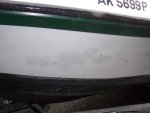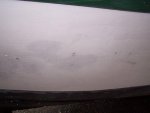Re: MarineTex for these screw holes?
Found about 12 of these screw holes in my new/used boat. above the h20 line, but in the splash zone. ...currently filled with some sort of caulk (sikaflex?)
Couple-o-things -
Unlikely your bullet holes are structural so for a seamless repair my idea is a fiberglass fill with a topping of gelcoat paste and a wet-sand & buff to compound them smooth with the surrounding area.
That caulk may have screwed up things some because it and the surface it's adhered to won't hold anything else. Meaning it has to go and a little sanding may be required to expose unadulterated fiberglass.
Marine-Tex is a pre-mixed epoxy. Epoxy adhesive mixed with a thickener additive to create a paste or putty. Not too different from the A-B epoxy in a tube you find at the hardware, only formulated for boat repairs.
Epoxy is a good patch material, but it isn't UV resistant. So, alone - over time - it will yellow and crack. Marine paint fixes that, but then you have paint dots.
I'd do a proper fiberglass hole repair, filling most of the thickness with resin thickened with a filler like cabosil or even milled fibers. The last bit, about the thickness of a dime at most, I'd fill with gelcoat paste. Once the gelcoat is in, tape over the spot to hold it from sagging and to reduce the amount of finish sanding needed.
Sand down to the surrounding surface then compound and polish to blend for near invisibility.






















